+ データを開く
データを開く
- 基本情報
基本情報
| 登録情報 | データベース: PDB / ID: 5wbh | ||||||
|---|---|---|---|---|---|---|---|
| タイトル | Structure of the FRB domain of mTOR bound to a substrate recruitment peptide of S6K1 | ||||||
 要素 要素 |
| ||||||
 キーワード キーワード | TRANSFERASE | ||||||
| 機能・相同性 |  機能・相同性情報 機能・相同性情報long-chain fatty acid import into cell / RNA polymerase III type 2 promoter sequence-specific DNA binding / RNA polymerase III type 1 promoter sequence-specific DNA binding / positive regulation of cytoplasmic translational initiation / regulation of locomotor rhythm / T-helper 1 cell lineage commitment / positive regulation of pentose-phosphate shunt / positive regulation of wound healing, spreading of epidermal cells / TORC2 signaling / TORC2 complex ...long-chain fatty acid import into cell / RNA polymerase III type 2 promoter sequence-specific DNA binding / RNA polymerase III type 1 promoter sequence-specific DNA binding / positive regulation of cytoplasmic translational initiation / regulation of locomotor rhythm / T-helper 1 cell lineage commitment / positive regulation of pentose-phosphate shunt / positive regulation of wound healing, spreading of epidermal cells / TORC2 signaling / TORC2 complex / regulation of membrane permeability / cellular response to leucine starvation / negative regulation of lysosome organization / heart valve morphogenesis / TFIIIC-class transcription factor complex binding / TORC1 complex / voluntary musculoskeletal movement / positive regulation of transcription of nucleolar large rRNA by RNA polymerase I / negative regulation of TORC2 signaling / calcineurin-NFAT signaling cascade / RNA polymerase III type 3 promoter sequence-specific DNA binding / positive regulation of keratinocyte migration / regulation of osteoclast differentiation / regulation of lysosome organization / MTOR signalling / cellular response to nutrient / cellular response to L-leucine / energy reserve metabolic process / Amino acids regulate mTORC1 / regulation of autophagosome assembly / Energy dependent regulation of mTOR by LKB1-AMPK / TORC1 signaling / ruffle organization / serine/threonine protein kinase complex / cellular response to methionine / negative regulation of cell size / positive regulation of ubiquitin-dependent protein catabolic process / cellular response to osmotic stress / negative regulation of protein localization to nucleus / anoikis / inositol hexakisphosphate binding / cardiac muscle cell development / negative regulation of calcineurin-NFAT signaling cascade / regulation of myelination / positive regulation of transcription by RNA polymerase III / negative regulation of macroautophagy / Macroautophagy / phosphatidylinositol-mediated signaling / positive regulation of myotube differentiation / regulation of cell size / Constitutive Signaling by AKT1 E17K in Cancer / positive regulation of actin filament polymerization / germ cell development / TOR signaling / behavioral response to pain / mTORC1-mediated signalling / oligodendrocyte differentiation / positive regulation of oligodendrocyte differentiation / positive regulation of translational initiation / CD28 dependent PI3K/Akt signaling / HSF1-dependent transactivation / regulation of macroautophagy / cellular response to dexamethasone stimulus / response to amino acid / 'de novo' pyrimidine nucleobase biosynthetic process / behavioral fear response / positive regulation of epithelial to mesenchymal transition / vascular endothelial cell response to laminar fluid shear stress / positive regulation of lipid biosynthetic process / heart morphogenesis / cellular response to nutrient levels / neuronal action potential / regulation of cellular response to heat / positive regulation of lamellipodium assembly / cardiac muscle contraction / phagocytic vesicle / T cell costimulation / positive regulation of stress fiber assembly / cytoskeleton organization / positive regulation of TORC1 signaling / protein serine/threonine/tyrosine kinase activity / endomembrane system / negative regulation of insulin receptor signaling pathway / positive regulation of mitotic cell cycle / negative regulation of autophagy / cellular response to amino acid starvation / positive regulation of translation / regulation of signal transduction by p53 class mediator / positive regulation of glycolytic process / cellular response to starvation / Regulation of PTEN gene transcription / VEGFR2 mediated vascular permeability / post-embryonic development / negative regulation of extrinsic apoptotic signaling pathway / TP53 Regulates Metabolic Genes / regulation of actin cytoskeleton organization / cellular response to amino acid stimulus / non-specific protein-tyrosine kinase / macroautophagy / phosphoprotein binding 類似検索 - 分子機能 | ||||||
| 生物種 |  Homo sapiens (ヒト) Homo sapiens (ヒト) | ||||||
| 手法 |  X線回折 / X線回折 /  シンクロトロン / シンクロトロン /  分子置換 / 解像度: 1.75 Å 分子置換 / 解像度: 1.75 Å | ||||||
 データ登録者 データ登録者 | Pavletich, N.P. / Yang, H. | ||||||
 引用 引用 |  ジャーナル: Nature / 年: 2017 ジャーナル: Nature / 年: 2017タイトル: Mechanisms of mTORC1 activation by RHEB and inhibition by PRAS40. 著者: Haijuan Yang / Xiaolu Jiang / Buren Li / Hyo J Yang / Meredith Miller / Angela Yang / Ankita Dhar / Nikola P Pavletich /  要旨: The mechanistic target of rapamycin complex 1 (mTORC1) controls cell growth and metabolism in response to nutrients, energy levels, and growth factors. It contains the atypical kinase mTOR and the ...The mechanistic target of rapamycin complex 1 (mTORC1) controls cell growth and metabolism in response to nutrients, energy levels, and growth factors. It contains the atypical kinase mTOR and the RAPTOR subunit that binds to the Tor signalling sequence (TOS) motif of substrates and regulators. mTORC1 is activated by the small GTPase RHEB (Ras homologue enriched in brain) and inhibited by PRAS40. Here we present the 3.0 ångström cryo-electron microscopy structure of mTORC1 and the 3.4 ångström structure of activated RHEB-mTORC1. RHEB binds to mTOR distally from the kinase active site, yet causes a global conformational change that allosterically realigns active-site residues, accelerating catalysis. Cancer-associated hyperactivating mutations map to structural elements that maintain the inactive state, and we provide biochemical evidence that they mimic RHEB relieving auto-inhibition. We also present crystal structures of RAPTOR-TOS motif complexes that define the determinants of TOS recognition, of an mTOR FKBP12-rapamycin-binding (FRB) domain-substrate complex that establishes a second substrate-recruitment mechanism, and of a truncated mTOR-PRAS40 complex that reveals PRAS40 inhibits both substrate-recruitment sites. These findings help explain how mTORC1 selects its substrates, how its kinase activity is controlled, and how it is activated by cancer-associated mutations. | ||||||
| 履歴 |
|
- 構造の表示
構造の表示
| 構造ビューア | 分子:  Molmil Molmil Jmol/JSmol Jmol/JSmol |
|---|
- ダウンロードとリンク
ダウンロードとリンク
- ダウンロード
ダウンロード
| PDBx/mmCIF形式 |  5wbh.cif.gz 5wbh.cif.gz | 404.1 KB | 表示 |  PDBx/mmCIF形式 PDBx/mmCIF形式 |
|---|---|---|---|---|
| PDB形式 |  pdb5wbh.ent.gz pdb5wbh.ent.gz | 333.8 KB | 表示 |  PDB形式 PDB形式 |
| PDBx/mmJSON形式 |  5wbh.json.gz 5wbh.json.gz | ツリー表示 |  PDBx/mmJSON形式 PDBx/mmJSON形式 | |
| その他 |  その他のダウンロード その他のダウンロード |
-検証レポート
| 文書・要旨 |  5wbh_validation.pdf.gz 5wbh_validation.pdf.gz | 461.3 KB | 表示 |  wwPDB検証レポート wwPDB検証レポート |
|---|---|---|---|---|
| 文書・詳細版 |  5wbh_full_validation.pdf.gz 5wbh_full_validation.pdf.gz | 462.2 KB | 表示 | |
| XML形式データ |  5wbh_validation.xml.gz 5wbh_validation.xml.gz | 21.6 KB | 表示 | |
| CIF形式データ |  5wbh_validation.cif.gz 5wbh_validation.cif.gz | 31.6 KB | 表示 | |
| アーカイブディレクトリ |  https://data.pdbj.org/pub/pdb/validation_reports/wb/5wbh https://data.pdbj.org/pub/pdb/validation_reports/wb/5wbh ftp://data.pdbj.org/pub/pdb/validation_reports/wb/5wbh ftp://data.pdbj.org/pub/pdb/validation_reports/wb/5wbh | HTTPS FTP |
-関連構造データ
- リンク
リンク
- 集合体
集合体
| 登録構造単位 | 
| ||||||||
|---|---|---|---|---|---|---|---|---|---|
| 1 | 
| ||||||||
| 2 | 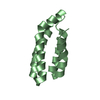
| ||||||||
| 3 | 
| ||||||||
| 4 | 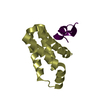
| ||||||||
| 5 | 
| ||||||||
| 単位格子 |
|
- 要素
要素
| #1: タンパク質 | 分子量: 12091.749 Da / 分子数: 5 / 断片: residues 2018-2114 / 由来タイプ: 組換発現 / 由来: (組換発現)  Homo sapiens (ヒト) / 遺伝子: MTOR, FRAP, FRAP1, FRAP2, RAFT1, RAPT1 / プラスミド: pET26 / 発現宿主: Homo sapiens (ヒト) / 遺伝子: MTOR, FRAP, FRAP1, FRAP2, RAFT1, RAPT1 / プラスミド: pET26 / 発現宿主:  参照: UniProt: P42345, non-specific serine/threonine protein kinase #2: タンパク質・ペプチド | | 分子量: 3057.544 Da / 分子数: 1 / 断片: residues 412-437 / 由来タイプ: 組換発現 / 由来: (組換発現)  Homo sapiens (ヒト) / 遺伝子: RPS6KB1, STK14A / プラスミド: pET26 / 発現宿主: Homo sapiens (ヒト) / 遺伝子: RPS6KB1, STK14A / プラスミド: pET26 / 発現宿主:  参照: UniProt: P23443, non-specific serine/threonine protein kinase #3: 水 | ChemComp-HOH / | |
|---|
-実験情報
-実験
| 実験 | 手法:  X線回折 / 使用した結晶の数: 1 X線回折 / 使用した結晶の数: 1 |
|---|
- 試料調製
試料調製
| 結晶 | マシュー密度: 2.77 Å3/Da / 溶媒含有率: 55.58 % / Mosaicity: 0.738 ° |
|---|---|
| 結晶化 | 温度: 289 K / 手法: 蒸気拡散法, ハンギングドロップ法 / pH: 7 / 詳細: tacsimate |
-データ収集
| 回折 | 平均測定温度: 100 K | ||||||||||||||||||||||||||||||||||||||||||||||||||||||||||||||||||||||||||||||||||||||||||||||||||||||||||||||
|---|---|---|---|---|---|---|---|---|---|---|---|---|---|---|---|---|---|---|---|---|---|---|---|---|---|---|---|---|---|---|---|---|---|---|---|---|---|---|---|---|---|---|---|---|---|---|---|---|---|---|---|---|---|---|---|---|---|---|---|---|---|---|---|---|---|---|---|---|---|---|---|---|---|---|---|---|---|---|---|---|---|---|---|---|---|---|---|---|---|---|---|---|---|---|---|---|---|---|---|---|---|---|---|---|---|---|---|---|---|---|---|
| 放射光源 | 由来:  シンクロトロン / サイト: シンクロトロン / サイト:  APS APS  / ビームライン: 24-ID-C / 波長: 0.9792 Å / ビームライン: 24-ID-C / 波長: 0.9792 Å | ||||||||||||||||||||||||||||||||||||||||||||||||||||||||||||||||||||||||||||||||||||||||||||||||||||||||||||||
| 検出器 | タイプ: ADSC QUANTUM 315 / 検出器: CCD / 日付: 2014年2月12日 | ||||||||||||||||||||||||||||||||||||||||||||||||||||||||||||||||||||||||||||||||||||||||||||||||||||||||||||||
| 放射 | プロトコル: SINGLE WAVELENGTH / 単色(M)・ラウエ(L): M / 散乱光タイプ: x-ray | ||||||||||||||||||||||||||||||||||||||||||||||||||||||||||||||||||||||||||||||||||||||||||||||||||||||||||||||
| 放射波長 | 波長: 0.9792 Å / 相対比: 1 | ||||||||||||||||||||||||||||||||||||||||||||||||||||||||||||||||||||||||||||||||||||||||||||||||||||||||||||||
| 反射 | 解像度: 1.75→50 Å / Num. obs: 66487 / % possible obs: 98.2 % / 冗長度: 4.9 % / Rmerge(I) obs: 0.068 / Rpim(I) all: 0.032 / Rrim(I) all: 0.076 / Χ2: 1.575 / Net I/σ(I): 11.6 / Num. measured all: 328879 | ||||||||||||||||||||||||||||||||||||||||||||||||||||||||||||||||||||||||||||||||||||||||||||||||||||||||||||||
| 反射 シェル | Diffraction-ID: 1
|
- 解析
解析
| ソフトウェア |
| |||||||||||||||||||||||||||||||||||||||||||||||||||||||||||||||||||||||||||||||||||||||||||||||||||||||||||||||||||||||||||||||||||||||||||||||||||||||||||||||||||||||||||||||
|---|---|---|---|---|---|---|---|---|---|---|---|---|---|---|---|---|---|---|---|---|---|---|---|---|---|---|---|---|---|---|---|---|---|---|---|---|---|---|---|---|---|---|---|---|---|---|---|---|---|---|---|---|---|---|---|---|---|---|---|---|---|---|---|---|---|---|---|---|---|---|---|---|---|---|---|---|---|---|---|---|---|---|---|---|---|---|---|---|---|---|---|---|---|---|---|---|---|---|---|---|---|---|---|---|---|---|---|---|---|---|---|---|---|---|---|---|---|---|---|---|---|---|---|---|---|---|---|---|---|---|---|---|---|---|---|---|---|---|---|---|---|---|---|---|---|---|---|---|---|---|---|---|---|---|---|---|---|---|---|---|---|---|---|---|---|---|---|---|---|---|---|---|---|---|---|---|
| 精密化 | 構造決定の手法:  分子置換 分子置換開始モデル: 1FAP 解像度: 1.75→50.01 Å / Cor.coef. Fo:Fc: 0.962 / Cor.coef. Fo:Fc free: 0.955 / SU B: 7.489 / SU ML: 0.102 / 交差検証法: THROUGHOUT / σ(F): 0 / ESU R: 0.111 / ESU R Free: 0.102 詳細: U VALUES : WITH TLS ADDED HYDROGENS HAVE BEEN USED IF PRESENT IN THE INPUT
| |||||||||||||||||||||||||||||||||||||||||||||||||||||||||||||||||||||||||||||||||||||||||||||||||||||||||||||||||||||||||||||||||||||||||||||||||||||||||||||||||||||||||||||||
| 溶媒の処理 | イオンプローブ半径: 0.8 Å / 減衰半径: 0.8 Å / VDWプローブ半径: 1.2 Å | |||||||||||||||||||||||||||||||||||||||||||||||||||||||||||||||||||||||||||||||||||||||||||||||||||||||||||||||||||||||||||||||||||||||||||||||||||||||||||||||||||||||||||||||
| 原子変位パラメータ | Biso max: 130.28 Å2 / Biso mean: 37.909 Å2 / Biso min: 12.88 Å2
| |||||||||||||||||||||||||||||||||||||||||||||||||||||||||||||||||||||||||||||||||||||||||||||||||||||||||||||||||||||||||||||||||||||||||||||||||||||||||||||||||||||||||||||||
| 精密化ステップ | サイクル: final / 解像度: 1.75→50.01 Å
| |||||||||||||||||||||||||||||||||||||||||||||||||||||||||||||||||||||||||||||||||||||||||||||||||||||||||||||||||||||||||||||||||||||||||||||||||||||||||||||||||||||||||||||||
| 拘束条件 |
| |||||||||||||||||||||||||||||||||||||||||||||||||||||||||||||||||||||||||||||||||||||||||||||||||||||||||||||||||||||||||||||||||||||||||||||||||||||||||||||||||||||||||||||||
| LS精密化 シェル | 解像度: 1.75→1.795 Å / Rfactor Rfree error: 0 / Total num. of bins used: 20
| |||||||||||||||||||||||||||||||||||||||||||||||||||||||||||||||||||||||||||||||||||||||||||||||||||||||||||||||||||||||||||||||||||||||||||||||||||||||||||||||||||||||||||||||
| 精密化 TLS | 手法: refined / Refine-ID: X-RAY DIFFRACTION
| |||||||||||||||||||||||||||||||||||||||||||||||||||||||||||||||||||||||||||||||||||||||||||||||||||||||||||||||||||||||||||||||||||||||||||||||||||||||||||||||||||||||||||||||
| 精密化 TLSグループ |
|
 ムービー
ムービー コントローラー
コントローラー







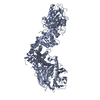




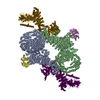




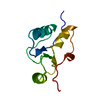

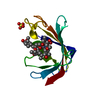



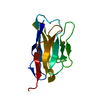
 PDBj
PDBj













